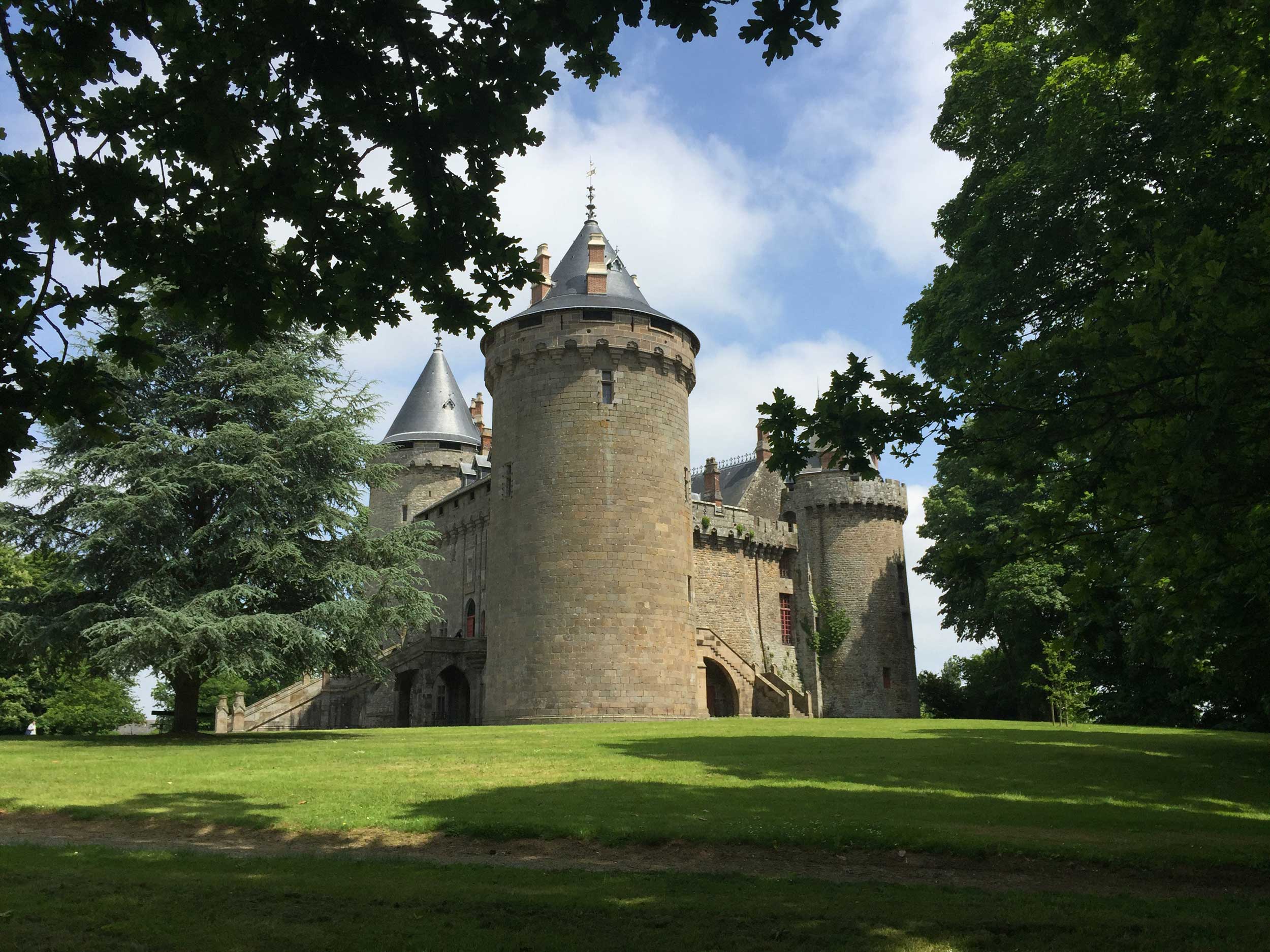The chateau
The first keep, the first lord. The Tour du Maure (Moor’s tower) was built at the beginning of the 11th century by the bishop of Dol for his brother Rivallon, who became the first lord of Combourg. His mission was to protect the cathedral of Dol, its lands and dependents.
In the 14thand 15th centuries, the defences were enlarged by the Tour de l’Est (East Tower), the Tour du Chat (Cat’s Tower) and the Tour du Croisé (Crossing Tower). The chateau defended the borders of Brittany, which was an independent state at that time. From then on, by way of Rennes and Saint Malo, between history and legend, the lords of Combourg continued right up to René-Auguste de Chateaubriand in the 18thcentury. His son, François-René, the famous writer and political figure immortalised this ‘four-wheeled cart’ in hisMemoires d’outre-tombe(Memoirs from beyond the grave). His words still resonate today in the great rooms where he passed his youth
Through the centuries
The chateau of Combourg, a medieval fortress built between the 12th and 15th centuries evokes the story of Brittany from the Middle Ages to our own time. It was to be marked by actual deeds and by legends, but above all by a single name: Chateaubriand. François-René, the family’s most illustrious representative, would immortalise it in his Memoirs de l’outre-tombe. By turn a protective fortress, the cradle of Romanticism and a military hospital, the chateau has had multiple lives. Today it is still inhabited by descendants of the famous author, and still an eloquent witness of its past history.
Rivallon, first lord of Combourg
The origins
It all started at the beginning of the 11th century. The lands of Dol, often opposed to the Duchy of Normandy, needed protection. So the bishop, Guinguené, had a keep built at Combourg for his brother Rivallon. The latter was the first lord of Combourg, ‘standard-bearer of Saint Samson’ as defenders of Dol were called.
This keep, reconstructed in the 12th and 13th centuries, would become the Tour du Maure. In the 14th century it was connected to the Tour de l’Est and the Tour du Chat. In the 15th century the Tour du Croisé and the north Façade completed the construction of the chateau. Together with Vitré and Fougères among other towns, Combourg formed the Marches of Brittany and resisted attacks in the medieval period, defending the border of an independent Brittany. During the Hundred Years War the lords of Combourg were involved in the struggles of succession to the Duchy of Brittany which set the kings of France and England against each other. Anne de Bretagne’s successive marriages to two French kings, Charles VIII and Louis XII, ended with the Duchy of Brittany becoming part of the kingdom of France in 1532.
René-Auguste de Chateaubriand buys the domain
In 1734, René-Auguste de Chateaubriand, youngest son of an illustrious family richer in honours than possessions, decided to do all he could to recover his noble heritage. He enlisted in the navy and later became a ship-owner, giving battle on several occasions, and made his fortune. In 1761 he purchased the chateau from his uncle, the Duke of Duras. The feudal fiefdom with its rights, vassals and traditions restored the distinction of the family. Having undertaken certain improvements to the interior of the chateau, the new Count of Combourg arrived from St-Malo in 1777 with his wife and five children. François-René was then eight years old. The description of his arrival at Combourg is the subject of one of the most famous passages in Memoirs de l’outre-tombe.
Coat of armes of Chateaubriand and its moto « My blood stained the banner of France »
The revolution
The French Revolution in 1789 marked a decisive stage in the history of Brittany. Before events in Paris, revolution burst out in Rennes on January 27th of that year. At the death of René-Auguste de Chateaubriand in 1787, Jean-Baptiste de Chateaubriand, older brother of the author, became the count of Combourg. A magistrate in the Parliament of Paris, he enlisted in the counter-Revolutionary army. During this period, the Chateau of Combourg was pillaged and ransacked, then confiscated.
During the Reign of Terror, Jean-Baptiste de Chateaubriand was arrested and guillotined on April 22nd 1794, together with his wife Aline de Rosambo, his parents-in-law and the grand-father of his wife, the famous Malesherbes, defender of Louis XVI. François-René, the younger brother and future author, returned from America and enlisted in the regiment of Navarre, joining the Army of the Princes at Namur. Wounded at the siege of Thionville, he was sent to recuperate with his uncle De Bedée on the island of Jersey, before setting out for England, where he lived in poverty as an immigrant until 1800.
The Chateau of Combourg was given back to the family in 1796 in a completely uninhabitable state. It was to remain in that condition for twenty-four years: the heir, son of Jean-Baptiste and nephew of François-René was then only seven years old. Louis-Geoffroy de Chateaubriand was brought up at Verneuil by his tutor and uncle Christian, Count of Tocqueville. He visited Combourg on various occasions but never lived there. He made one of the main rooms, the Salle des Gardes, available to the children of the village, so they could all receive an education. His financial contributions were to facilitate the foundation of the first college of Combourg. This situation lasted for two years, during which time, the college of Saint Guildin was built.
From the second half of the 19th century the Chateau of Combourg, made famous by François-René de Chateaubriand in his Memoirs de l’outre-tombe, became a place of literary pilgrimage. Gustave Flaubert and Maxime du Camp have left us an accurate if melancholy description of the chateau in their account Par les champs et les Grèves. Maurice Barrès saw it as ‘the proof in stone of a major work in words’.
Drawing of the castle XIXe century
The restauration Néo-Gothique
In 1875, Geoffroy, grandson of Jean-Baptiste, returned to the chateau and had it restored with the intention of transforming a medieval fortress into a living space for a family of the 19th century. The park was designed at that time in English style by Denis and Eugène Buhler. They were inspired by Memoirs de l’outre-tombe and recreated the Cour Verte, the great and small avenues, and pathways lined by oak, lime and chestnut. The castle was restored in the spirit of contemporary Neo-Gothic by Ernest Thrile, influenced by the style of Eugène Viollet-le-Duc. The Salle des Gardes was divided into two, creating a salon and a dining-room. The interior courtyard was reduced in size in order to provide space for a grand central staircase and a level to join the north and south logis. Influenced by Viollet-le-Duc, the décor of the walls of the rib-vaulted entry hall tells the glorious history of the Chateaubriand family.
Sybille, the youngest daughter of Geoffroy and the countess of Durfort, inherited the chateau in her turn. She made it into a military hospital for convalescence during the First World War. In 1961 she left the chateau to Geoffroy, Count de la Tour du Pin Verclause, her great nephew. This ensured it remained in the family, as is the case to this day.
Rose Chateaubriand « Prix of Rome 2007 »
The Park
François-René de Chateaubriand called it ‘the tranquil lake’. Its legendary name is ‘Lake of Diane’. The story goes that its origin lay in the anger of an old woman who made the spring of Margatte overflow. Each year on September 4th, the Foire de l’Angevine (Angevine Fair) takes places beside this lake.
The sense of joy this inspired, which was depicted by Chateaubriand, was as rare as it was ephemeral. It gave way to other days of the particular melancholy so dear to the famous author










